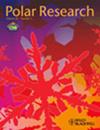斯匹次卑尔根岛北部的比勒约登断裂带:一个主要的岩层边界?
IF 1.3
4区 地球科学
Q3 ECOLOGY
引用次数: 3
摘要
比勒约登断裂带是挪威北极地区的主要地壳边界。该断层分离了斯瓦尔巴东北和西北地体的基底岩,这些地体记录了离散的前寒武纪构造热史,并在加里东造山运动期间被增生、剧烈变形和变质。虽然该断层代表了一个主要的地壳尺度构造边界,但其向北延伸的范围并没有得到很好的约束。目前的简短贡献解决了这个问题,并提出了Wijdefjorden北部构造和岩石单元的新地震作图,Billefjorden断裂带可能继续存在。研究表明,没有证据表明存在顶基底反射的大断裂,因此,Billefjorden断裂带可能在Wijdefjorden-Austfjorden范围内消失,台阶≥20 km,或者在现有的地震资料中不可见。地震资料还表明,Ny-Friesland(东北地体)加里东期基底岩与andrsamae Land(西北地体)泥盆系地堑下基底岩没有显著差异。潜在的影响包括斯匹次卑尔根岛北部缺少一个主要的地形边界。本文章由计算机程序翻译,如有差异,请以英文原文为准。
The Billefjorden Fault Zone north of Spitsbergen: a major terrane boundary?
The Billefjorden Fault Zone is a major terrane boundary in the Norwegian Arctic. The fault separates basement rocks of Svalbard’s north-eastern and north-western terranes that recorded discrete Precambrian tectonothermal histories and were accreted, intensely deformed and metamorphosed during the Caledonian Orogeny. Although the fault represents a major, crustal-scale tectonic boundary, its northward extent is not well constrained. The present short contribution addresses this issue and presents new seismic mapping of structures and rock units north of Wijdefjorden, where the Billefjorden Fault Zone may continue. This study shows that there is no evidence for major faulting of the top-basement reflection, and therefore, that the Billefjorden Fault Zone may die out within Wijdefjorden–Austfjorden, step ≥ 20 km laterally, or be invisible on the presented seismic data. Seismic data also suggest that Caledonian basement rocks in Ny-Friesland (north-eastern terrane) are not significantly different from basement rocks below the Devonian Graben in Andrée Land (north-western terrane). Potential implications include the absence of a major terrane boundary in northern Spitsbergen.
求助全文
通过发布文献求助,成功后即可免费获取论文全文。
去求助
来源期刊

Polar Research
地学-地球科学综合
CiteScore
3.20
自引率
5.30%
发文量
22
审稿时长
>12 weeks
期刊介绍:
Since 1982, Polar Research has been the international, peer-reviewed journal of the Norwegian Polar Institute, Norway''s central institution for research, environmental monitoring and mapping of the polar regions. Aiming to promote the exchange of scientific knowledge about the Arctic and Antarctic across disciplinary boundaries, Polar Research serves an international community of researchers and managers. As an open-access journal, Polar Research makes its contents freely available to the general public.
Original primary research papers comprise the mainstay of Polar Research. Review articles, brief research notes, letters to the editor and book reviews are also included. Special issues are published from time to time.
The scope of Polar Research encompasses research in all scientific disciplines relevant to the polar regions. These include, but are not limited to, the subfields of biology, ecology, geology, oceanography, glaciology and atmospheric science. Submissions from the social sciences and those focusing on polar management and policy issues are welcome. Contributions about Antarctica are particularly encouraged.
 求助内容:
求助内容: 应助结果提醒方式:
应助结果提醒方式:


